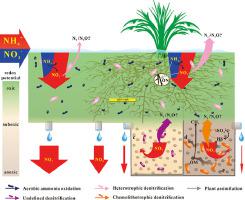Water Research ( IF 11.4 ) Pub Date : 2021-11-25 , DOI: 10.1016/j.watres.2021.117895 Liuqin Huang 1 , Junyue Luo 2 , Linxin Li 2 , Hongchen Jiang 1 , Xiaoxi Sun 2 , Jian Yang 2 , Weiyu She 2 , Wen Liu 2 , Liqing Li 3 , Allen P Davis 4

|
Bioretention systems are environmentally friendly measures to control the amount of water and pollutants in urban stormwater runoff, and their treatment performance for inorganic N strongly depends on various microbial processes. However, microbial responses to variations of N mass reduction in bioretention systems are complex and poorly understood, which is not conducive to management designs. In the present study, a series of bioretention columns were established to monitor their fate performance for inorganic N (NH4+and NO3−) by using different configurations and by dosing with simulated stormwater events. The results showed that NH4+ was efficiently oxidized to NO3−, mainly by ammonia- and nitrite-oxidizing bacteria in the oxic media, regardless of the configurations of the bioretention systems or stormwater conditions. In contrast, NO3− removal pathways varied greatly in different columns. The presence of vegetation efficiently improved NO3−mass reduction through root assimilation and enhancement of microbial NO3− reduction in the rhizosphere. The construction of an organic-rich saturation zone can make the redox potential too low for heterotrophic denitrification to occur, so as to ensure high NO3− mass reduction mainly via stimulating chemolithotrophic NO3− reduction coupled with oxidation of reductive sulfur compounds derived from the bio-reduction of sulfate. In contrast, in the organic-poor saturation zone, multiple oligotrophic NO3− reduction pathways may be responsible for the high NO3− mass reduction. These findings highlight the necessity of considering the variation of N bio-transformation pathways for inorganic N removal in the configuration of bioretention systems.
中文翻译:

影响雨水生物滞留柱无机氮去除关键因素的非常规微生物机制
生物滞留系统是控制城市雨水径流中的水量和污染物的环保措施,其对无机氮的处理性能很大程度上取决于各种微生物过程。然而,微生物对生物截留系统中氮质量减少变化的反应是复杂的且知之甚少,这不利于管理设计。在本研究中,建立了一系列生物滞留柱,通过使用不同的配置和模拟暴雨事件的剂量来监测其对无机氮(NH 4 +和NO 3 - )的归宿性能。结果表明,无论生物滞留系统的配置或雨水条件如何,NH 4 +主要被含氧介质中的氨氧化细菌和亚硝酸盐氧化细菌有效氧化为NO 3 - 。相反,NO 3 -去除途径在不同的柱中差异很大。植被的存在通过根同化和根际微生物NO 3 -减少的增强,有效地改善了NO 3 -质量的减少。富含有机物饱和区的构建可以使氧化还原电位太低而无法发生异养反硝化,从而主要通过刺激化能自养NO 3 -还原以及源自有机物的还原性硫化合物的氧化来确保高NO 3 -质量还原。硫酸盐的生物还原。 相反,在贫有机物饱和区,多种寡营养NO 3 -还原途径可能是造成NO 3 -质量大量减少的原因。这些发现强调了在生物滞留系统的配置中考虑去除无机氮的氮生物转化途径的变化的必要性。











































 京公网安备 11010802027423号
京公网安备 11010802027423号